We do not know under what circumstances Prince Rupprecht of Bavaria discovered the long-forgotten treasure of Persian carpets and kilims in the Wittelsbach Palace which eventually led to the creation of the 1910 exhibition of Islamic art in Munich,the so-called “Masterpieces of Mohammedan Art”. The Prince recognised the value of his discovery,and formed a committee to present it to the public.The idea was taken up in Munich`s artistic circles,mutating first into a concept for a general exhibition of Oriental Carpets,and then into one of Islamic Art. The previous year in Munich a show of Japanese art had been received favourably,and suitable premises already existed in Munich`s Bavaria Park,the purpose built exhibition center not far from the Oktoberfest grounds.The organizers settled on F.R Martin initially,and then recruited Friedrich Sarre from Berlin as artistic director.Martin proved to be a damp squib,but did write a chapter for the catalogue as well as filling up the halls with his goods.Care was taken to avoid the bazaar atmosphere of the 1891 Vienna show,but it was deemed necessary to include a hall for dealers,amongst whom Bernheimer was the most prominent.Indeed,the Munich Hoflieferant had been instrumental in assembling a human zoo of “Islamic” workers and craftsman,whose goods,produced live during the exhibition,could also be purchased In situ.
 |
| Bernheimer`s stand at the 1910 Fair |
 |
| Native workers |
The MMK exhibition was not only one of the greatest in extent,with 3572 exhibits spread over 80 Galleries,but also one of the most poorly documented.The surviving photos reveal a sepuchral atmosphere,of which just three photos were printed in the 3-Volume catalogue.The first shows the Representation Room,an entrance to the show based upon Persian Iwan-style models;then a shot of the “Mosque” Room with many carpets lain out,strangely reminiscent of the Alaeddin Mosque once visted by Friedrich Sarre;and room 72 with its exhibits.Although 1.5 million tickets to the Exhibition Grounds were sold,we have no record of the actual visitors to the exhibition itself.It seems to have been treated negligently by the Press,which expected a bazaar-like ambient ,and not a modern presentation. The general approach of the show was monolithic, designed to focus the viewer`s attention purely upon the objects themselves.The 1001 Nights atmosphere which was customary at the time when dealing with things oriental had been discarded,an approach also fostered by Benno Becker and the Deutsche Werkbund.
50 carpets were reproduced in the 3-Volume catalogue;a fourth Volume was never published as such but contains extra reproductions,including 17 carpets.Seven items are no longer traceable:
Plate 64) A Safavid silk kilim,Roden Collection Frankfurt.
Plate 68) A North-West Persian Animal carpet,with Kouchakji Bros. in Paris.
Plate 72) A Lotto carpet fragment with coat of arms,Limburger Collection,Leipzig.
Plate 75) A Cairene prayer carpet,once with Prince Liechtenstein in Vienna.
From the unpublished Volume IV:
Plate 29) A Red Ground Floral Carpet,once with Böhler in Munich.
Plate 102) The Woworsky Animal carpet.The reproduction in Bode,1922 has been used here.
Plate 176) An Indian carpet with Palmettes and Racemes.No other publication.
The following is a colour re-enactment of the 1912 catalogue,Meisterwerke Muhammedanischer Kunst.
42 & 43)Already a star since its appearance at the 1891 Vienna exhibition,and subsequently one of the most reproduced of all carpets,the Vienna silk hunting carpet forms the spearhead of a group lent by the Emperor of Austria,presumably through the mediation of his close relative the Bavarian Prince Ruprecht.It is said to have arrived in a case with a large glass cover,and was exhibited on a podium in room 5.It represents the most ambitious implementation of a miniature painting in knotted form.On its faded red ground, 58 hunters hurtle through gravity-free space,surrounded by a border of drunken angels.They seem bemused by such human folly.Curiously,each seated figure has his foot positioned at an impossible angle. Large organised hunts were witnessed by western travellers,and apart from the obvious joy in carnage,also served to prepare less experienced warriors with a closeup experience of bloodshed-hence the graphic depictions of swords cutting into the animals` flesh.Why such a border scene was chosen is anyone`s guess,but it is a key to understanding the carpet`s meaning.The Rothschild-Boston carpet has a simplified version with master and servant,but see plate 61. 323 x 693 cms.
 |
| 44 |
44) The Gulbenkian silk Keshan,formerly with Bode,sold by the Schloss Museum through an agent in Amsterdam in 1936,to help finance the purchase of the Guelph Treasure.A member of a small group with Medallion and Animal Combat scenes,which includes a fragment in the Louvre(Pope 1198) and the missing Branicki carpet.Animals in free-fall combined with a swooping bird border,also featured on the Altmann rug in the MET(14.40.721)Called by Sarre the “Pheasant” carpet. 177 x 235 cms.
 |
| 45 |
45) The Schwarzenberg carpet,now in Doha.First published in the Wienerwerk,and subsequently many times,this features the bucolic scenery of animals trees,flowers et al,described in Pope`s worn phrase of “Paradise Park”.It certainly has everything a self-respecting Safavid carpet should have,from its duck-pond medallion with strap-work lacing(later misappropriated by so many Bakshaish rugs) to the border modelled on the Chelsea-Lees-Williams carpets.In the corners a Phoenix has angled himself a plump chicken,and a bird below looks up in dismay.The swooping Feng-huang reappears many times in late 19th century Iran rugs. 270 x 570 cms.
 |
| 46 |
46)The Buquoy Medallion carpet was already illustrated in colour in the Wienerwerk,but after 1910 seems to have dropped out of sight.Sarre lists it as being held at Rosenberg Castle,in present-day Czechoslovakia,where the family was domiciled since the 17th Century.A similar carpet,destroyed in 1945,was once in the Berlin Collection. 278 x 525 cms.
 |
| 47 |
47) The Czartoryski Salting Carpet,Cracow.An incredibly elaborate example which could be placed in a group with the Salting Carpet itself.Said to have been acquired at the Siege of Vienna,and always in the possession of the Czartoryski family.Stolen during the Second World War,but later recovered in 1946.National Museum Cracow. 165 x 250 cms.
 |
| 48 |
 |
| 48a-missing section |
48 & 48a) Lent by Lionel Harris of the Spanish Art Galleries,50 Conduit Street,London.A member of the whiteground-border Bacri-type which has been discussed HERE.The carpet was later shortened and is now in the Tehran Carpet Museum.A missing section was once with the Rockefellers,later in the Wher Collection via the Textile Gallery,Herrmann X and Sothebys 1988. 300 x 580 cms.
 |
| 49 |
 |
| 49a |
49)The Lees Williams Tree carpet,now in Philadelphia.A very influential carpet in the 19th century; its border also showed up in the strangest of places. 353 x 550 cms.
 |
| 50 |
50) The Clam Gallas,a frequently reproduced carpet,features an overall design presumably derived from the Lyons-MET pair,although more coarsely woven and employing shrub forms between the cassettes in place of arabesques.The border system echoes that of the Ardabil carpet.However,the field layout was also used as a border,from which it may have eventually derived. 270 x 540 cms.
 |
| 51 |
51) The Tucher medallion carpet,now in the Textile Museum.This was with Bernheimer in the 1926 Chicago show,but had been published earlier by Scala/Sarre in 1908,and by Orendi.With single colour inset lobes in the medallion,which was lain over an arabesque field.For Sarre,one of the oldest carpets in the exhibition.180 x 454 cms.
 |
| 52 |
52) A Vase Carpet,now in the Topkapi Museum.Belonging to the rare “Big-Leaf” compartment lattice group,often confused with another Vase carpet group,of a type discussed here-Vase carpets. 285 x 480 cms.
 |
| 53 |
53) A classic example of a Vase Carpet then with the Stemrich Collection in Berlin,and now in the Art Institute Chicago,Inventory Nr. 1944.3,gift of William Deering Howe.With the uncommon Lotus-Leaf Rosette border.135 x 370 cms.
 |
| 54 |
54) The Figdor Garden Carpet.A compartment rug unlike any others of this group.Small,with metal-thread brocading,and a looser weave than most Vase Carpets,to which group it has sometimes been attributed.The light,simple border and relaxed style are reminiscent of Khorasan.151 x 187 cms.
 |
| 55 |
 |
55a |
55 & 55a) The Residence Silk and Metal Animal Combat Rug.One of the pieces discovered by Prince Rupprecht in the Residence,Munich.Not a Polonaise carpet,despite Sarre`s description,as it is too much in the style of a bucolic Paradise Park rug,and there are no pictorial Polonaise rugs of this type.Perhaps not really very old,although it is ascribed to the dowry of Anna Katharina Konstanze,in 1642.However,there is no proof whatsoever that this is true.The repeat design of the field indicates a textile influence. Warp: cotton.Weft:cotton and wool.Described by Sarre as Wavy(1st) and Straight(2nd) which cannot be accurate.(Perhaps he meant 3 rows of weft) 136 cms x 206 cms.
 |
| 56 |
56) Polonaise carpet,Liechtenstein Collection Vienna.Despite the fanciful reproduction from the Wienerwerk shown here,still one of the noblest Polonaise carpets in the arabesque style.Subsequently published by Bode,Pope and Achdjian.See Spuhler,Polonaise dissertation, entry 149.Since 1893 in the possession of Prince Johan II of Liechtenstein.139 x 210 cms.
 |
| 57 |
 |
| 57a |
57 & 57a)A silk Keshan carpet,transferred from the Residenz to the Bavarian National Museum,Munich,in 1857.One of a group of three with a Strapwork surrounding the medallion,the other two being the Altman carpet,Metropolitan Museum NY14.40.724,and a carpet in Coimbra,Portugal.The author has never recovered from having seen this at the Munich retrospective in 2010.150 x 244 cms.
 |
| 58 |
58) A Polonaise carpet,in 1910 with Hoflieferant(Royal Warranty) A.S Drey,Munich.Now in the Detroit Institute of Art,gift of Edsel Ford (F 67.2).Formerly in the Lelong Collection and purchased by Ford from Parish-Watson.136 x 203 cms.
 |
| 59 |
59) A Polonaise carpet with Count Potocki in Cracow in 1910,but now in the Markische Museum in Berlin.It appears to have been in the possession of the clothing company Quantmeyer & Eicke,Berlin,in 1942,and having survived the war entered the museum.Unusual for its figurative depictions,which resemble Classical Persian textiles of the 16th century.The weaver`s uncertainty with the design can be seen in the squeezed right hand side elements,but it remains a charming piece.See Spuhler 152 and 171 where a companion piece is said to habe been with Count Sanguszko.The small size is also unusual: 99 x 170 cms.
 |
| 59 |
 |
| 59a |
59 & 59a)One of two fragments from a Saf.Ellis and Kamada favour an Indian provenance,Sarre a Persian. This piece went to Ballard and is now in the MET 22.100.72.Sarre refers to its previous publication by Martin(196),but he actually published the other piece with a white upper panel. 103 x 232 cms.
 |
| 60 |
 |
| 60a |
60,60a) One of a pair of silk kilims,Persia 16th century,bearing the arms of Sigismund III of Poland.Said to have been part of the dowry of his daughter Constance,for her marriage to the Wittelsbacher Phillip William in 1642. It goes mostly unmentioned in the literature that these are a pair.The collage of the two pieces(60a) shows the MMK piece on the right.The colours in the Blazon have been mis-managed. 135 x 250 cms.
 |
| 61 |
 |
| 61a-Miho Museum |
61 & 61a) Another silk kilim from the Wittelsbach Residence,certainly the most dramatic item of the group.There are two outstanding problems,still to be solved;where are the side borders,and why are the human faces unfinished?There is a vague similarity to the Vienna Hunting carpet,but in the kilim the Ruler of the World,attended by Peris,sits on a throne,entertained by dancers and musicians.If anything the field is more ferocious than the hunting carpet, the medallion psychedelic.The same Reality-Distortion technique can be observed in the Rothschild-Miho example,sold at Christies on 8 July 1999 for $ 1,339,960(lot 189)Recent snapshots of the Munich kilim show what appears to be a significant loss of colour,but perhaps the repros in Sarre-Trenkwald have suffered Kodak enhancement? Sarre mentions the fresh colours,though. 152 x 389 cms.
 |
| 62 |
62) A further silk kilim from the Wittelsbach family treasure.Good colour reproductions are unknown,although a snapshot exists in which gold colour of the ground has mutated to a green.148 x 356 cms.When will the authorities in Munich publish the complete collection?
 |
| 63 |
63) The illustrious Figdor Kilim,once in the Thyssen Collection and now in the Miho Museum.One of three examples with multi-palmette arrangement depicting animals.The other two are the superior Franchetti example,now in Doha,and the battle-coat of Hideyoshi in Japan.As with a number of other examples in this group,the designs have been influenced by the Sanguszko carpets.Indeed,the tension generated is caused by seeing rug designs woven in a foreign technique.125 x 192 cms.
 |
| 64 |
64)A Safavid silk kilim from the Roden Collection in Frankfurt,which seems to have disappeared.Silver ground,red medallion and blue corners.Cotton warp(?)A more flowery,kilim-like style. 127 x 238 cms.
 |
| 65 |
65) A Dragon carpet in 1910 with Istanbul dealers Weise and Matthieu.Later in the Remarque /Godard Collection,and sold at Sothebys on 3 February 1977(281)Said by Yetkin to have settled in a Chicago Collection,where its de-restored condition can now be seen.This was also the starting point for a number of Tuduc fakes.Given an Armenian origin by Martin and Sarre.240 x 475 cms.
 |
| 66 |
 |
| 66a |
66 & 66a)The Lamm Tree-Compartment rug,which has devolved from the Clam Gallas field design(Tafel 50)Attributed to Khorasan on the basis of Jufti knotting,which occurs in 19th century carpets from the region,as in many others.Published by Martin in 1908 as being at Naesby House,this was sold at the Andersen Gallery sale in 1923.It resurfaced at Sothebys London(not Monte Carlo,as Spuhler states) where it sold on 18 April for GBP 20,900(212)Thence to Thyssen.Another montage shows it with two similar pieces,the McMullan and Barbieri(Oriental Stars)Martin locates this rug to the same area as the Dragon Carpet. 220 x 520 cms.
 |
| 67 |
 |
| 67a-Berlin |
 |
67b-keir |
67,67a,67b)A damaged fragment from the Lees Williams Collection,now in Philadelphia.A similar fragment was once in Berlin,destroyed during the war,and a complete example of rarified beauty was in the Keir Collection. 230 x 330 cms.
 |
| 68 |
68) The Kouchakji Carpet,18th Century or later.N.W Persia or S.Caucasus,but attributed by Sarre to Asia Minor.The Peacocks tails connect with the top border to form a mihrab.Blue ground,cotton warp.For a further discussion of the Animal carpet group see HERE-004-013.Attributed to Armenia by Sarre.200 x 290 cms.
 |
| 69 |
69)From the Djerra-Pasha Mosque in Istanbul,later in the Topkapi Palace Museum.Now TIEM.An allover Palmette design carpet of intimidating scale.223 x 444 cms.
 |
| 70 |
70) A large Star Ushak carpet with blue ground lotus border.This is likely to be the piece in the Ryksmuseum,now quite damaged.In 1910 with the dealer A.S Drey in Munich.For a thorough rundown of Ushak carpets see Ushakistan. 215 x 390 cms.
 |
| 71 |
71)A large Medallion Ushak carpet in the Haniel Collection,now Bruschettini.There are two treatments of the medallion in such carpets:one is composed of split-leaf arabesques,transposed onto the ground colour(as here)The other has a medallion within the medallion on a solid ground colour.One of the best LMU carpets.247 x 380 cms.
 |
| 72 |
72)A Lotto carpet with Genoese coat of arms.Collection Martina Limburger in Leipzig.Now lost to sight,this carpet inspired a number of Tuduc fakes.The Leipzig carpet is in the Anatolian style,whereas the fakes,including a pretty rug in the McMullan Collection,are always in the more prosaic Kilim style. 110 x 213 cms.
By good fortune the Limburg fragment surfaced at Rippon-Boswell`s sale of 29 May 2021:-
 |
| 72 |
72) A Persian prayer rug in the Salting style,Topkapi Museum Istanbul.This carpet seems to be still in the Topkapi,but despite frequent publication,the author could find no colour reproduction.It is of the simpler Salting style,without metal-thread.Said to be from the tomb of Sultan Selim I. Dark blue ground,cotton structure.The inscription is the classic admonishment to pray before death. 97 x 164 cms.
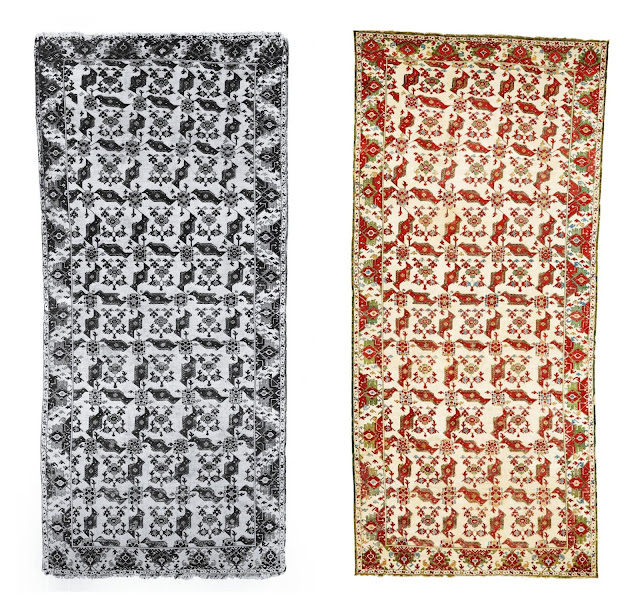 |
| 73 |
73) A Selendi Bird carpet from the collection of Kurt Zander in Berlin,later with Cassirer.In Hali 168 the carpet is discussed by A.Beselin. Erdmann published the piece twice as “formerly Berlin,private possession”-presumably referring to Cassirer.On offer at Sothebys in October 2020. 215 x 400 cms.An entry concerning these carpets can be found here:Selendi
 |
| 74 |
74) A Turkish prayer rug in the Cairene style,purchased originally by Lessing.Still in Berlin.127 x 172 cms.
74b) The Vienna Cairene prayer rug,still in the MAK.Further discussion see City Victorious 117 x 183 cms.
 |
| 75 |
75)A Cairene prayer rug formerly with Prince Liechtenstein in Vienna.Sold on 1 July 1920 and since lost to sight.Originally purchased from Bardini on 27 June 1887. 137 x 210 cms.
 |
| 76 |
76) A Cairene carpet in 1910 with Baron Tucher in Vienna.This subsequently passed to Judge Gary in 1928,and re-appeared at Lefevre in 1984 when it sold for 25,000 GBP(later Wher Collection)Sold again at Rippon Boswell on 17 November 2001 for $ 74,580.Last auctioned at the AAC Vienna for $ 55,265.139 x 212 cms.
 |
| 77 |
77) The second supreme carpet loaned by the Emperor of Austria,now in the MAK Vienna.The silk Mamluk,the only known of type,with an unparalleled aura.280 x 542. Mamluke carpet review The Geometric Gardens.
 |
| 78 |
 |
| 78a |
78 & 78a) The Simonetti Mamluk carpet.The only example with 5 medallions,like a giant runner.Now in the MET,New York. 224 x 878 cms.
 |
| 79 |
79) A pretty Mamluk carpet from the Berlin Collection.A gift to the Museum from Bode,in 1905. 139 x 200 cms.
 |
| 80 |
80) The carpet with Cranes and other birds,now in the Vienna MAK,is justly iconic.It entered the museum in 1889,and has been reproduced many times.In the border,pairs of leopards lie in wait for their prey.Clearly a wall-hanging,it should be viewed in context with the Boston Museum`s pictorial rug. 156 x 235 cms.
 |
| 81 |
81) Another of the world`s great carpets,this prayer rug entered the Museum in 1868 from the Mechitarist Closter.More info 166 A-G. 108 x 155 cms.
 |
| 82 |
82) An Indian animal carpet,in the collection of C.F Kartaus,Potsdam.Exhibited in 1949 in Delft,Collection von Pannwitz.Sold at the Voytec Blau Sale,Sothebys New York on 14 December 2006(lot 54) for $385,000.There are very few Indian Animal-Combat rugs:mostly the scenes portrayed depict a chase,La Chasse spirituelle. 160 x 230 cms.
 |
| 83 |
 |
| 83a |
83,83a) A silk carpet of questionable age,yet published already by Martin in 1908.It is modelled on the Paravacini carpet,said to be in a Belgian private collection(Jean Pincket),which is certainly an irreproachable item.A third rug was in the McMullan,now MET Collection(formerly Yerkes).The silk rug was with Benguiat in 1930 and 1932,and re-appeared at Christies on 5 May 1977(32) where it sold for 4000 GBP-as a Turkish silk rug.Since its entry into the Khalili Collection is has experienced a severe re-evaluation,now placed again in the pantheon of Mughal rugs.Its colour is insipid,and the drawing not up to the level of the other two pieces.Of course,it is woven in another medium,silk,whereas the other two items are in Pashmina wool.In 1910 it was with Isaac Sassoon in London.156 x 196 cms.
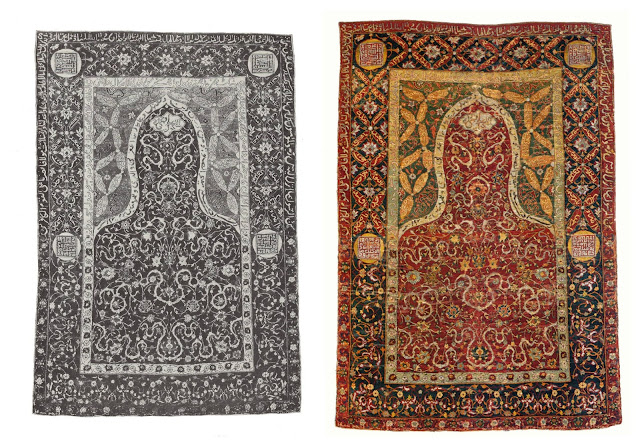 |
| 83 |
83) A Salting prayer rug,once with Kelekian,and in 1910 with Julius Böhler.Published countless times due to its extraordinary quality.Said by Sarre to have been discovered in Istanbul in “extremely desolate condition” and to have been “successfully restored”Purchased by The Louvre in 2011. 100 x 158 cms.
 |
| 84-Paris |
 |
| 84-Frankfurt |
84) Two Indian “Grotesque” fragments from a pair(?) of carpets scattered far and wide.The French fragment from the Jeuniette Collection is now in the Louvre;the Frankfurt Roden piece went to the Homberg Collection and thence to the Detroit Institute of Arts (32.64)
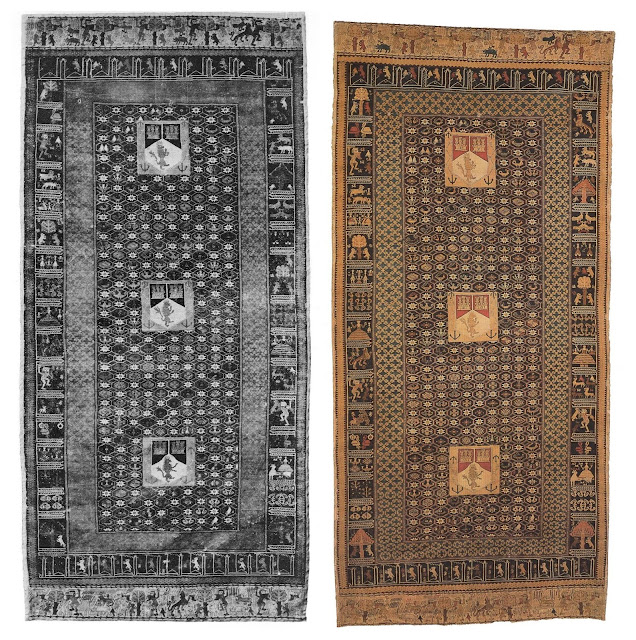 |
| 85 |
 |
| 85a |
85,85a)Three Spanish carpets were lent to the exhibition by Lional Harris,who ran the Spanish Art Gallery in London`s Conduit Street.The first of two “Admiral” carpets is said to have been in the Santa Clara Cloister in Palencia.Known as the Enriquez Carpet due to the coat of arms of Admiral Enriquez,grandfather of the king and father-in-law of another.A gift of Joseph Lees Williams to the Philadelphia Museum of Art in 1921. 264 x 590 cms.
 |
| 86 |
86) The second Admiral carpet,bearing not only the Arms of Fadrique Enriquez but those of his wife Marina de Ayala.Now at the Vizcaya Museum in Miami.230 x 800 cms.
 |
| 87 |
87) An Anatolian style Spanish carpet,in 1910 with Bürkel in Munich,and now in the MET(13.193.2)Probably the best of a rare group. 165 x 284 cms.
Carpets from Volume IV of the MMK catalogue,unpublished.
 |
| 3 |
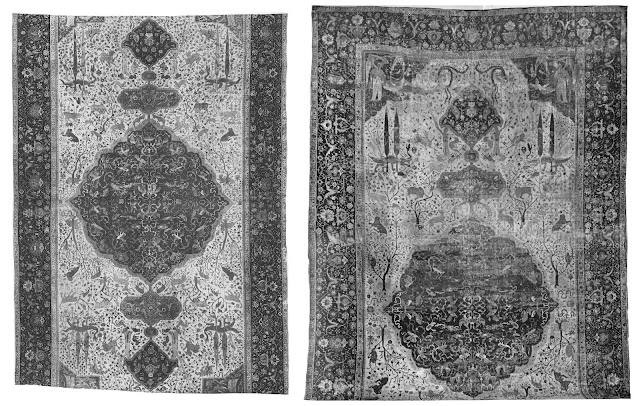 |
| 3 & 3a |
3 & 3a) Purchased by Wilhelm von Bode in Venice in 1891,this carpet has a counterpart in the Getty Museum,LACMa,the so-called Coronation Carpet.This is extremely fortunate as the Bode carpet had its corner-pieces removed at some point,and was anyway virtually obliterated at the end of the war in Berlin.Now only a reassembled quarter remains.The size of the Coronation Getty Carpet is 366 x 701 cms.
 |
| 5 |
 |
| 5 |
 |
| 5 |
5) The Lees Williams Animal-Garden carpet fragment,now in Philadelphia.Its great beauty is best appreciated in an enhanced photo of the back,as the carpet has suffered extensive restoration,now faded.457 x 515 cms.
 |
| 7 |
 |
| 7 |
7)The Sarre animal-combat carpet,now in Doha.Its companion,once with Yerkes,is in the MET New York (10.61.2) Said to have come from Ardabil.Sold by Sarre via A.U Pope to Rockefeller in the 1920`s. 178 x 333 cms.
 |
| 18 |
 |
18 |
18 & 19) Two fragments from an Emperor`s style carpet with white-ground “ Bacri” border.The field piece is in the North Bohemia Museum,Liberec,Czech Republic.95 x 310 cms.The corner piece is in the MAK,Vienna.135 x 181 cms.Further discussion Lineage.
 |
| 21 |
21)With Julius Böhler,distinguished Munich art dealer who lent a number of carpets.This fragment was reunited with its other half from the Schürmann estate in Hamburg in 2016.The complete carpet,on a silk warp,measures 256 x 516 cms.
 |
| 22 |
 |
| 22a |
 |
22b |
22,a,b) A section of carpet from the De Motte Red Ground Floral carpet in the Textile Museum,in 1910 with Bernheimer. More info see Lineage-58
 |
| 23 |
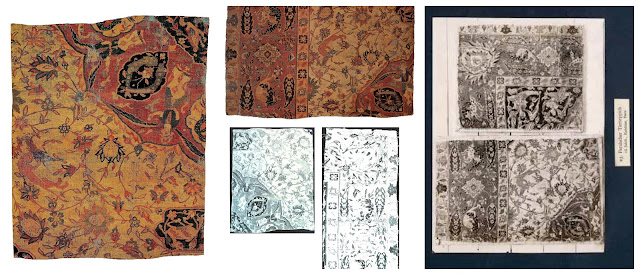 |
| 23 |
23)Two fragments from a Sanguszko carpet,which have been transformed into three pieces,of which a part is missing.There is said to be another piece in Boston,perhaps the missing strip.Now Textile Museum.Formerly Kelekian Collection.
 |
| 29 |
29) An unidentified RGF in large format with a ragged-palmette border.The thumbnail on the NY Public Library website makes it impossible to identify. The author is grateful to Christian Erber,Munich, for providing a working photo.It would appear to be an outstanding example,but has not re-emerged.Lent by Julius Böhler.
 |
| 54 |
 |
| 54 |
54) Said to be in the possession of J.Halnauer in Berlin.Curiously foreshortened,but a cut is not visible.Published by Bernheimer in 1959(“Kirman 18the Century”) and later by Schürmann in 1965("Isfahan 1800”)this carpet has no direct counterparts.The border is of the traditional “Khorasan” type,but whiteground arabesque field designs are rarely encountered until the 19th century.It may even be Indian. 255 x 272 cms.
 |
| 59 |
 |
| 59 |
59) A highly attractive Garden Carpet from the Lamm Collection,sold at the Andersen Sale in 1923,and subsequently gifted from Ballard to the MET (22.100.128)
 |
| 82 |
82) The pair to Nr 60 in the catalogue,a silk kilim with the Vasa shield.On this example the adjoined animals flanking the shield are missing.
 |
| 93 |
 |
| 93 |
93) The Lamm Dragon Carpet from Naesby House,published by Martin in 1908.Apparently Martin bought the carpet in Cairo in 1896,and sold it to Lamm. It was sold at the Andersen Sale of 1923,and purchased by Myers.A n outstanding example,now in the Textile Museum. 175 x 358 cms.
 |
| 102 |
 |
| Thyssen |
102) The Woworsky Animal-Garden Carpet.Published by Bode in 1922,but now missing,and no colour photo exists.However a carpet in the Thyssen Collection is quite similar.More info Golden Triangle 115 x 250 cms.
 |
176 |
176) An Indian carpet with racemes and palmettes,lent by the Spanish Art Galleries.It seems to have disappeared,and no colour photo is available.Too close to the Potsdam-Zaleski carpet(82) and not as good,to have made it into the catalogue.
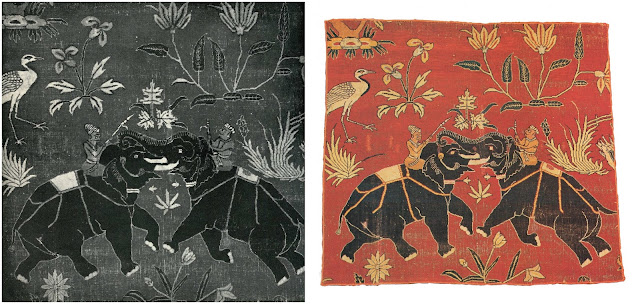 |
| 178 |
178) A well-known Indian carpet fragment once with Friedrich Sarre,now in the Textile Museum.
 |
| 194 |
194) A carpet with the blazon of Mniszech and Potocki,and the Grand Crown Hetman,Poland,18th Century.Now in the National Museum,Warsaw.
The original 3-Volume version of MMK came packed in a special box and weighed in at 30 kilos.The author has used the reprint from Alexandria Press,1984.It was reviewed by Danny Shaffer in Hali 27,page 65.
The original catalogue is also available for download through the Internet Archive: MMK download
The acknowledged expert on all things MMK is Eva-Maria Troelenberg.Her doctoral thesis was published in German as :
Eine Ausstellung wird Besichtigt(Peter Lang 2011)
An English summary can be read HERE
See also Hali 165-90.
On the 100 year anniversary of the show,a retrospective was held in Munich with a catalogue:
The Future of Tradition-The Tradition of Future(Prestel 2010)
Available online at Future of Tradition
The seminar to that event can be viewed here: after one hundred years
 |
| Prince Rupprecht of Bavaria |












No comments:
Post a Comment
Note: only a member of this blog may post a comment.